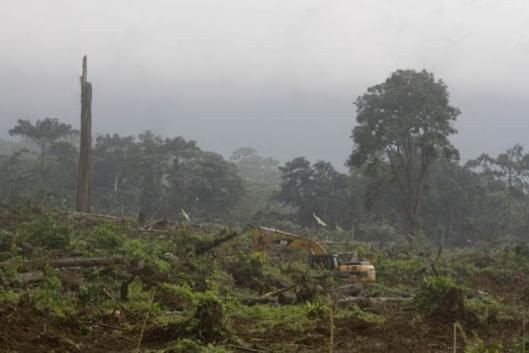In one of his last works – “Oil palm in Africa: Past, present and future scenarios”, published in December 2010 – our beloved friend and colleague Ricardo Carrere provided an overview of the history and current status of monoculture oil palm plantations in Africa (see http://wrm.org.uy/oldsite/
Oil palm is a traditional crop in numerous African countries, used for the artisanal production of a wide range of products for household and local use, from baskets woven from its leaves to palm wine, in addition to the oil extracted from the tree, which has played an important role in many local economies.
However, the international demand for palm oil for the food and cosmetics industries and, more recently, for the production of agrofuels, opened the way to the expansion of large-scale oil palm plantations, promoted by large agribusiness companies.
In the case of São Tomé and Príncipe, oil palm grows naturally on the two islands that make up the country. However, its use dates back to the era of the Portuguese invasion of the islands, which were uninhabited at the time. When the Portuguese introduced sugar cane cultivation based on slave labour, it led to the forced arrival of Africans from Benin, Congo and Angola, who brought with them the traditional uses of this palm.
Following São Tomé and Príncipe’s independence in 1975, financing from the European Investment Bank and the European Community were used to establish 650 hectares of oil palm plantations and a palm oil factory (Empresa de Óleos Vegetais - EMOLVE) in the south of São Tomé island.
EMOLVE eventually halted production, but in 2009 the Belgian-French company Socfinco arrived in the country. Registered locally as Agripalma, it is part of the powerful Bolloré investment group, based in France.
Socfinco planned to establish 5,000 hectares of oil palm plantations on the islands of Príncipe and São Tomé to supply palm oil for the production of agrofuel in Belgium.
In 2009, the government signed an agreement with Agripalma for the concession of the land area needed for the project, but according to the local digital publication Téla Nón, the population of Príncipe opposed the agreement and prevented the establishment of industrial oil palm plantations on their island from destroying more than 1,000 hectares of forests.
On the island of São Tomé, however, the agreement prospered, and the government even managed to obtain more land to make up for the 1,000 hectares denied to the company on Princípe and thus to fulfil the agreement with Agripalma.
As a result, the inhabitants of São Tomé began to see bulldozers advancing on the pristine forests of the southern region of the island, where exuberant natural vegetation, nourished by various rivers and streams, spreads along the country’s largest hydrographic basin.
Agripalma’s bulldozers are also affecting the local population’s food supply, particularly coconuts, a staple food that is becoming increasingly scarce. “Our parents and grandparents cultivated the land here. And now they have taken all of the land away from us so that Agripalma can plant oil palms. Coconuts are one of the things that guarantee a source of food for us here, and they are going to destroy all of the coconut trees. What kind of life will we have?” asked a young man from the village of Monte Mário.
“The government decided that it would be more advantageous for the country to trade all of its biodiversity, unique in the world, for a few tons of oil!” was another of the complaints that began to be voiced as the destruction advanced.
As a result, some inhabitants of São Tomé began to mobilize to fight against what they consider to be an environmental crime committed by Agripalma. They went to court to request an injunction against the advance of the company’ bulldozers and chainsaws in the forests in the south of the island, specifically in the area of the Obo nature reserve.
In late July, the court ruled in their favour and established restrictions on Agripalma’s activities, prohibiting the company from clearing forests in the vicinity of the Obo nature reserve, on hills, in coastal areas, and in other areas where these activities could endanger or destroy protected flora and fauna. The judge who issued the ruling also stipulated that Agripalma must leave a 40-metre-wide strip of vegetation along the banks of all rivers, streams and lagoons. This means the company is already guilty of an infraction, because, according to Téla Nón, there is a large deforested area practically on the banks of the Caué River where several hundred oil palms have already been planted. The forest cover on the hill near the river has also been destroyed in order to plant oil palms.
The court ruled that the Agripalma project must be rescaled to a land area that will not affect the reserve. This renders the project practically unfeasible, given the lack of lands that both comply with this requirement and serve the company’s interests.
While the court ruling did not halt Agripalma’s activities, it established a series of limitations that have curbed them, and for the group of citizens who mobilized in response to the advance of the oil palm plantations, this signifies a victory. Above all, the ruling demonstrates that the power to confront destruction lies in organized popular resistance.
Based on information from: “Tribunal mostra sinal de STOP à empresa Agripalma” , agosto de 2013, Abel Veiga, Diario Digital de São Tomé e Príncipe -TÉLA NÓN, http://www.telanon.info/
